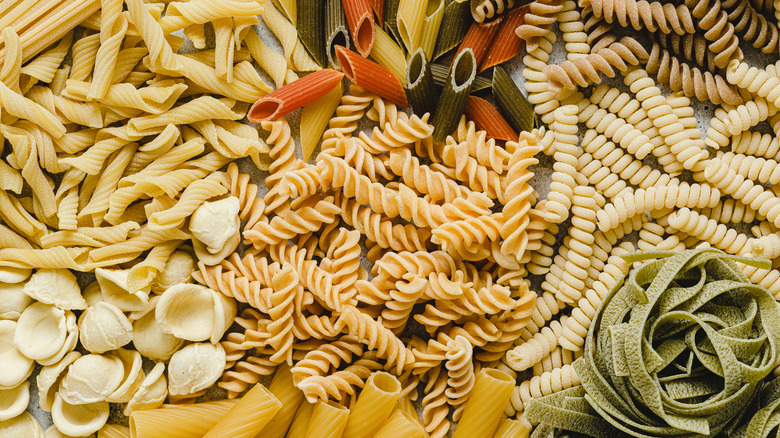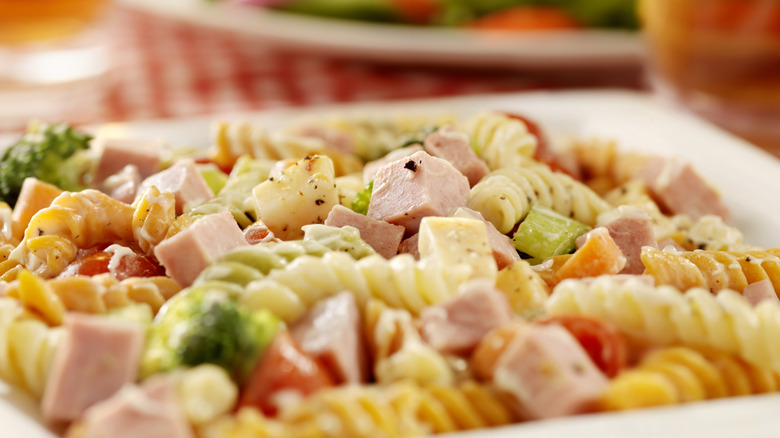Why Your Pasta Salad Doesn't Taste Like What You Get At The Deli (And How To Fix It)
Summer potluck, picnic and barbecue fare are pretty standard, and most likely, you can count on at least one container of pasta salad. It's a reliable expectation to have at warm-weather gatherings, and for good reason. With Mediterranean roots, pasta salad became a refreshing way to enjoy a cultural staple on a hot day. Its American popularity surged after World War II, sparking countless cookbook recipes and packaged mixes for homemade versions. But today, the best pasta salad often come from delis.
Although it's relatively easy to make at home, your pasta salad probably doesn't taste as good as what you get at the deli for a few reasons: you're using the wrong pasta, there's an opportunity to incorporate better mix-ins and fresher vegetables, and/or your dressing and overall flavors need some work. But don't worry — your days of making disappointing pasta salad end now. To that end, we asked the chefs at Reser's Fine Foods, one of the country's largest family-owned prepared foods companies, to provide some suggestions on how to make your homemade pasta salad deli-worthy.
Pick the Right Pasta
First and foremost: The best pasta salads start with the right pasta shapes — but what are they? "Shapes with lots of nooks, crannies, and ridges are ideal," says the team. Farfalle, fusilli, penne, rigatoni, and rotini are also great options that let the dressing permeate their textured surfaces. But liquid absorption doesn't just depend on the shape. Did you know how pasta is manufactured determines how well it can hold sauces?
When dough is fed through a pasta machine, it gets shaped by metal plates called dies, which create heat and friction. Bronze is the traditional die material because of how it helps dissolve the generated heat. According to Reser's, "Bronze dies in pasta machines create a rougher, porous surface on pasta, which helps sauces and dressings adhere better, and enhances the overall flavor and texture of the salad."
Today, those dies usually have a nonstick coating, which puts less wear on the machines. Chemical coatings like Teflon are smooth, and so is the pasta it yields, which means a lot of pasta you find in stores isn't riddled with small holes and dents that hold liquid. See if you can spot any of those pasta shapes with "bronze-cut" or "bronze-die" on its packaging next time you're at the supermarket. You'll get more flavor in every bite.
Be Creative With Quality Ingredients
Now that you have your pasta of choice, the next step is to consider other ingredients. "Focus on fresh, seasonal vegetables and inclusions," say the experts at Reser's. Get colorful and creative while keeping it old school. "Classic vegetables include celery, carrots, red onion, cherry tomatoes, and black olives." You can mix in steamed broccoli florets for creaminess and nutritional value, blue cheese to up the pasta salad's umami, or pickle juice to amp up the tanginess. To vary the texture, try adding farro or quinoa, using multiple pasta shapes, frying canned artichokes, or even chopping up deli meat. "We all eat with our eyes first, so add colorful inclusions that make the salad 'pop' visually," the Reser's chefs explain. "Incorporating all these items into a salad provides [a] balance of flavor, texture, and visual appeal." Regardless of what you mix in, you want a good pasta-to-inclusion ratio.
Quintessential pasta salad seasonings include mustard, vinegar, garlic, and herbs, while olive oil, sour cream and mayo offer creaminess to your dressing (just don't overdo it on the mayo or you'll get macaroni salad instead). No matter what you include, remember this key step: "Allowing the salad to chill in the refrigerator for at least an hour (or even overnight) lets the flavors meld together, enhancing a 'deli-style' taste," says the Reser's team. Enjoy impressing your friends and family at the next potluck!


